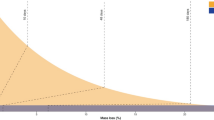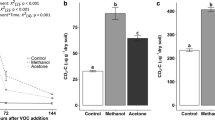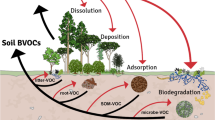Abstract
Substantial amounts of volatile organic compounds (VOCs) can be released during decomposition and these compounds can affect atmospheric chemistry, belowground processes, and the structure of microbial communities in litter and soil. However, we have a limited understanding of the types, quantities and ecological impacts of VOCs emitted from litter. Here we used a closed flow-through system and proton transfer reaction mass spectrometry (PTR-MS) to characterize VOC emissions from soil and two litter types (Pinus taeda and Acer rubrum) over a 72-day incubation period. Microbial respiration rates were measured throughout the incubation, and the soils were harvested at the end of the incubation to determine how litter VOCs influenced soil C dynamics, N mineralization rates, and bacterial communities. Using the PTR-MS we identified over 100 VOCs, with 10 VOCs making up the majority of emissions. VOCs accounted for up to 2.5% of the C flux from litter. Soil was a net sink of litter VOCs, absorbing up to 80% of VOCs released by litter, and exposure of soil to litter VOCs increased microbial respiration rates in soil by up to 15%. However, we observed negligible impacts of litter VOCs on soil nutrient levels and bacterial community structure, suggesting that soils must be exposed to higher concentrations of VOCs than observed in our study, to cause effects on these soil characteristics. Overall, VOCs appear to have an important influence on C dynamics at the soil-litter interface and VOC emissions from decomposing litter may represent an understudied component of biosphere–atmosphere interactions.






Similar content being viewed by others
References
Amaral JA, Knowles R (1997) Inhibition of methane consumption in forest soils and pure cultures of methanotrophs by aqueous forest soil extracts. Soil Biol Biochem 29:1713–1720
Amaral JA, Knowles R (1998) Inhibition of methane consumption in forest soils by monoterpenes. J Chem Ecol 24:723–734
Asensio D, Penuelas J, Filella I, Llusia J (2007) On-line screening of soil VOCs exchange responses to moisture, temperature and root presence. Plant Soil 291:249–261
Bunge M, Araghipour N, Mikoviny T, Dunkl J, Schnitzhofer R, Hansel A, Schinner F, Wisthaler A, Margesin R, Mark TD (2008) On-line monitoring of microbial volatile metabolites by proton transfer reaction-mass spectrometry. Appl Environ Microbiol 74:2179–2186
Cleveland CC, Yavitt JB (1998) Microbial consumption of atmospheric isoprene in a temperate forest soil. Appl Environ Microbiol 64:172–177
de Gouw J, Warneke C, Karl T, Eerdekens G, van der Veen C, Fall R (2003) Sensitivity and specificity of atmospheric trace gas detection by proton-transfer-reaction mass spectrometry. Int J Mass Spectrom 223:365–382
DeSantis TZ, Hugenholtz P, Larsen N, Rojas M, Brodie EL, Keller K, Huber T, Dalevi D, Hu P, Andersen GL (2006) Greengenes, a chimera-checked 16S rRNA gene database and workbench compatible with ARB. Appl Environ Microbiol 72:5069–5072
Fierer N, Schimel JP, Holden PA (2003) Variations in microbial community composition through two soil depth profiles. Soil Biol Biochem 35:167–176
Fierer N, Hamady M, Lauber CL, Knight R (2008) The influence of sex, handedness, and washing on the diversity of hand surface bacteria. Proc Natl Acad Sci 105:17994–17999
Hamady M, Walker JJ, Harris JK, Gold NJ, Knight R (2008) Error-correcting barcoded primers for pyrosequencing hundreds of samples in multiplex. Nat Methods 5:235–237. doi:10.1038/nmeth.1184
Isidorov V, Jdanova M (2002) Volatile organic compounds from leaves litter. Chemosphere 48:975–979. doi:PIIS0045-6535(02)00074-7
Jacob DJ, Field BD, Jin EM, Bey I, Li Q, Logan JA, Yantosca RM, Singh HB (2002) Atmospheric budget of acetone. J Geophys Res 107(D10):4100
Kesselmeier J, Staudt M (1999) Biogenic volatile organic compounds (VOC): an overview on emission, physiology and ecology. J Atmos Chem 33:23–88
Lauber CL, Strickland MS, Bradford MA, Fierer N (2008) The influence of soil properties on the structure of bacterial and fungal communities across land-use types. Soil Biol Biochem 40:2407–2415. doi:10.1016/j.soilbio.2008.05.021
Lauber CL, Hamady M, Knight R, Fierer F (2009) Pyrosequencing-based assessment of soil pH as a predictor of soil bacterial community structure at the continental scale. Appl Environ Microbiol 75:5111–5120. doi:10.1128/AEM.00335-09
Leff JW, Fierer N (2008) Volatile organic compound (VOC) emissions from soil and litter samples. Soil Biol Biochem 40:1629–1636. doi:10.1016/j.soilbio.2008.01.018
Lindinger W, Hansel A, Jordan A (1998) On-line monitoring of volatile organic compounds at pptv levels by means of proton-transfer-reaction mass spectrometry (PTR-MS) medical applications, food control and environmental research. Int J Mass Spectrom Ion Process 173:191–241. doi:10.1016/S0168-1176(97)00281-4
Litvak ME, Madronich S, Monson RK (2008) Herbivore-induced monoterpene emissions from coniferous forests: Potential impact on local tropospheric chemistry. Ecol Appl 9:1147–1159
Lozupone CA, Knight R (2005) UniFrac: a new phylogenetic method for comparing microbial communities. Appl Environ Microbiol 71:8228–8235. doi:10.1128/AEM.71.12.8228-8235.2005
Lozupone CA, Knight R (2008) Species divergence and the measurement of microbial diversity. FEMS Microbiol Rev 32:557–578. doi:10.1111/j.1574-6976.2008.00111
Lozupone CA, Hamady M, Knight R (2006) UniFrac: an online tool for comparing microbial community diversity in a phylogenetic context. Bioinformatics 7:371. doi:10.1186/1471-2105-7-371
Mackie AE, Wheatley RE (1999) Effects and incidence of volatile organic compound interactions between soil bacterial and fungal isolates. Soil Biol Biochem 31:375–385
Mayrhofer S, Mikoviny T, Waldhuber S, Wagner AO, Innerebner G, Frank-Whittle IH, Mark TD, Hansel A, Insam H (2006) Microbial community related to volatile organic compound (VOC) mission in household biowaste. Environ Microbiol 8:1960–1974. doi:10.1111/j.1462-2920.2006.01076
Monson RK (2002) Volatile organic compound emissions from terrestrial ecosystems: A primary biological control over atmospheric chemistry. Isr J Chem 42:29–42
Monson RK, Holland EA (2003) Biospheric trace gas fluxes and their control over tropospheric chemistry. Annu Rev Ecol Syst 32:547–576
Neff JC, Asner GP (2001) Dissolved organic carbon in terrestrial ecosystems: synthesis and a model. Ecosystems 4:29–48. doi:10.1007/s100210000058
Owen SM, Clark S, Pompe M, Semple KT (2007) Biogenic volatile organic compounds as potential carbon sources for microbial communities in soil from the rhizosphere of Populus tremula. FEMS Microbiol Lett 268:34–39. doi:10.1111/j.1574-6968.2006.00602
Paavolainen L, Kitunen V, Smolander A (1998) Inhibition of nitrification in forest soil by monoterpenes. Plant Soil 205:147–154
Richter D, Markewitz D (2001) Understanding soil change. Cambridge University Press, Cambridge, UK
Schade GW, Crutzen PJ (1999) CO emissions from degrading plant matter (II): estimate of a global source strength. Tellus B 51:909–918. doi:10.1034/j.1600-0889.1999.t01-4-00004
Schade GW, Goldstein AH (2001) Fluxes of oxygenated volatile organic compounds from a ponderosa pine plantation. J Geophys Res 106:3111–3123
Schink B, Zeikus J (1980) Microbial methanol formation: a major end product of pectin metabolism. Curr Microbiol 4:387–389. doi:10.1007/BF02605383
Smolander A, Ketola RA, Kotiaho T, Kanerva S, Suominen K, Kitunen V (2006) Volatile monoterpenes in soil atmosphere under birch and conifers: effects on soil N transformations. Soil Biol Biochem 38:3436–3442. doi:10.1016/j.soilbio.2006.05.019
Stahl PD, Parkin TB (1996) Microbial production of volatile organic compounds in soil microcosms. Soil Sci Soc Am J 60:821–828
Stotzky G, Schenck S (1976) Volatile organic compounds and microorganisms. CRC Crit Rev 4:333–381
Tsuji K, Tsien HC, Hanson RS, DePalma SR, Scholtz R, LaRoche S (1990) 16S ribosomal RNA sequence analysis for determination of phylogenetic relationship among methylotrophs. J Gen Microbiol 136:1–10
Vespermann A, Kai M, Piechulla B (2007) Rhizobacterial volatiles affect the growth of fungi and Arabidopsis thaliana. Appl Environ Microbiol 73:5639–5641. doi:10.1128/AEM.01078-07
Warneke C, Karl T, Judmaier H, Hansel A, Jordan A, Lindinger W, Crutzen PJ (1999) Acetone, methanol, and other partially oxidized volatile organic emissions from dead plant matter by abiological processes: significance for atmospheric HO x chemistry. Global Biogeochem Cycles 13:9–17
Wheatley R (2002) The consequences of volatile organic compound mediated bacterial and fungal interactions. Antonie van Leeuwenhoek 81:357–364. doi:10.1023/A:1020592802234
Wheatley RE, Millar SE, Griffiths DW (1996) The production of volatile organic compounds during nitrogen transformations in soils. Plant Soil 181:163–167. doi:10.1007/BF00011303
Wheatley R, Hackett C, Bruce A, Kundzewicz A (1997) Effect of substrate composition on production of volatile organic compounds from Trichoderma spp. inhibitory to wood decay fungi. Int Biodeterior Biodegradation 39:199–205
White CS (1988) Nitrification inhibition by monoterpenoids: theoretical mode of action based on molecular structures. Ecology 69:1631–1633. doi:10.2307/1941663
Zhao J, Zhang R (2004) Proton transfer reaction rate constants between hydronium ion (H3O+) and volatile organic compounds. Atmos Environ 38:2177–2185. doi:10.1016/j.atmosenv.2004.01.019
Acknowledgements
We would like to thank members of the Fierer lab for their valuable comments on previous drafts of this manuscript. We would also like to thank Mark Bradford and Mike Strickland for their help with sample collection, Rob Knight and Micah Hamady for their help with the sequence analyses, Michael Wilkinson for his guidance and aide in sampling, and Russ Monson for making the PTR-MS available for our use. Finally, we thank the three anonymous reviewers for their thoughtful comments. This work was funded by grants awarded to N.F. from the National Science Foundation and the Andrew W. Mellon Foundation.
Author information
Authors and Affiliations
Corresponding author
Rights and permissions
About this article
Cite this article
Ramirez, K.S., Lauber, C.L. & Fierer, N. Microbial consumption and production of volatile organic compounds at the soil-litter interface. Biogeochemistry 99, 97–107 (2010). https://doi.org/10.1007/s10533-009-9393-x
Received:
Accepted:
Published:
Issue Date:
DOI: https://doi.org/10.1007/s10533-009-9393-x




